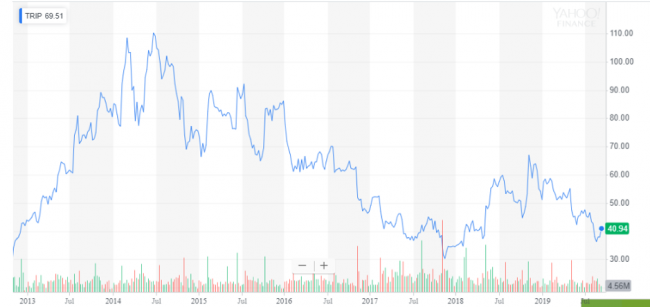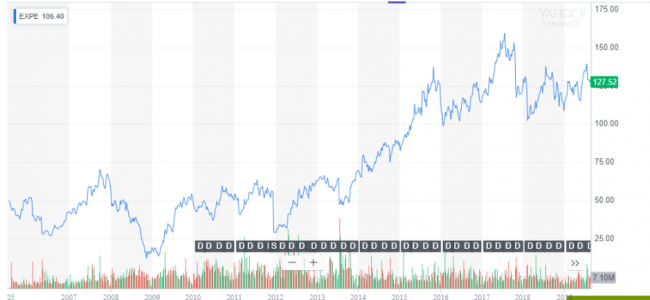I enjoy reports on social trends and demographic data. The information shapes my view on megatrends and informs some long-term stock selections.
Megatrends, of course, are well known to the market and usually reflected in fulsome stock prices. Also, top-down trends are only part of the puzzle; assessing companies and valuations on a case-by-case basis is key. Megatrends have a habit of seducing novice investors.
Still, the market too often underestimates the power and duration of megatrends. Often, stocks leveraged to powerful social, demographic or technology themes are overhyped and their valuations overshoot. When their earnings disappoint, the stock is dumped.
That could be the case with the online bookings megatrend, involving millennials (roughly 23-38 years old) and travel. We have barely scratched the surface of an incredible trend that will last for decades, influence consumption of cars and homes, and affect the labour market.
A story in the Australian Financial Review this week explained why more inner-city millennials are avoiding car ownership. They would rather use public transport, Uber or ride a bike than borrow to buy a car and pay for registration, insurance, fuel and maintenance.
The majority of millennials, particularly those in outer suburbs or regional areas, still need a car to get to work and live. But if I were a car manufacturer, I would be worried about future car ownership rates among younger generations and whether structural change will hurt the industry.
A front-page story in The Australian this week analysed declining home ownership among young people. Based on the Australian Institute Health and Welfare 2019 Report, the story explained why people are less likely to own their own home with each passing generation. Sadly, younger people are likelier to rent than buy because of high house prices.
Elsewhere, I read about a start-up that enables young people to rent their wardrobe. Why buy a dress for the school prom or race day when you can rent one from a similar consumer? It was yet another example of booming growth in the “sharing economy”.
It is not hard to join the dots: younger people are spending less on expensive products that tie them down, so they can spend more on services, such as travel, and have greater flexibility. Lifestyles will change dramatically when fewer young people are not locked into 30-year home loans, car loans or paying off other expensive products.
This trend to “live light” and reduce fixed costs coincides with growth in the gig economy, where people work on short-term projects. As job security decreases, and younger people move between projects, it is inevitable they will have more time and flexibility for experiences.
Travel is a huge winner from this trend. Most twenty-somethings I know (usually family members or children of friends) seem to work for one reason: to pay for travel. Several worked part-time jobs, built a decent nest-egg, then blew it on a worldwide trip.
That’s just in Western countries. Imagine what will happen when hundreds of millions of millennials in emerging markets join the middle-class in the next decade. Like their Australian peers, they will want to travel overseas (although hopefully save more at the same time).
Changing travel habits are another growth driver. Gone are the days when young people planned their first big overseas trip a year in advance through a travel agent. Now they book online, often on a whim. Cheap international airfares make it easier to nip off to Bali for a week, staying in a trendy hotel or vacation house, booked on an online platform.
I see years of growth ahead for travel companies exposed to online bookings. The key is knowing when to buy the best operators, because they are usually fully priced, and being prepared to look overseas because ASX has only a handful of investment-grade travel stocks.
Here are two global travel stocks that look interesting at current prices. Long-term investors might watch and wait for better value and look to add them to their portfolio during market corrections as we enter the traditionally weaker September/October period.
1. TripAdvisor Inc (Nasdaq: TRIP)
Most readers would be familiar with the online American travel and restaurant aggregator, having been blasted by TripAdvisor’s TV ads or used it services to research or book a holiday.
TripAdvisor is thought to be the world’s biggest travel site, attracting hundreds of millions of people each year. It is estimated that one in 10 internet users visit TripAdvisor annually to start their decision-making process for a holiday or book it online.
TripAdvisor is a case study in the power of “network effects”. As more people use its site, more reviews are posted, attracting other users. Motels and hotels might bemoan the margin TripAdvisor takes from bookings, but they cannot afford to be without it. Just as many takeaway joints that complain about Uber cannot survive without its food-ordering platform.
For all its potential, TripAdvisor has fallen from US$110 in June 2014 to US$40. The stock ran too far, too fast, at the start – as often happens in megatrends – and sank when the market became concerned about competition and TripAdvisor’s slowing growth and profit margins.
TripAdvisor’s second-quarter earnings missed Wall Street’s expectations and revenue fell year-on-year – a bad sign for a high-growth company. That market is worried that Google will eat into the online booking market for hotels, restaurants and other experience. More on that later.
Negatively abounds about TripAdvisor. Analysts are concerned the company’s core hotel-booking business is slowing and that initiatives to boost the non-hotel business will take time to translate into earnings. Stock recommendations for TripAdvisor are being downgraded.
But every stock has its price. An average share price target of US$48.82 based on the consensus of 22 broking firms suggests TripAdvisor is undervalued at the current US$40. Most analysts have a hold rating on TripAdvisor as they look for signs of stronger growth.
TripAdvisor’s trailing price-earnings (PE) ratio of 41 times is pricey, even for a dominant global online company. The main attraction is cash flow: TripAdvisor’s free cash flow is more than twice its reported income and means the stock trades on about 14 times free cash flow (after adjusting the company’s market capitalisation for its large cash holding).
That is attractive for a company that should grow annual earnings at double-digit rates for years, according to consensus forecasts. For all the challenges, TripAdvisor is still a leading player in a global online bookings market and has good long-term growth prospects.
Nevertheless, I would not be surprised to see TripAdvisor test previous price support around US$34 in a nervous market over the next few months. If it can hold that support, TripAdvisor shareholders might get a holiday from the negativity overhanging the stock.
TripAdvisor

Source: Yahoo Finance
2. Expedia Group Inc. (Nasdaq: EXPE)
Online US travel agency, Expedia, has also had a tougher time on the market in the past few years, its stock falling from US$161 in mid-2017 to US$130. Expedia almost fell below US$100 early last year as the market fretted about its growth, before slowly recovering.
The stock lost favour this year after its first-quarter earnings report slightly disappointed. The market is concerned Expedia’s home-rental segment is losing ground to Airbnb and that rising US-China trade tensions and a softening US economy will hurt travel demand.
Like its rival TripAdvisor, Expedia also faces a competitive threat from Google’s aggressive push into online hotel and restaurants bookings. As early movers such as TripAdvisor and Expedia disrupted industry incumbents, so too could Google disrupt online travel aggregators. Travel competition from Amazon is another emerging concern.
Expedia stock has outperformed TripAdvisor over the past three years and looks more attractively priced on the basis of enterprise value (EV) to earnings before interest tax, depreciation and amortisation (EBITDA). Expedia’s EV/EBITDA of 14 compares to 18 for TripAdvisor – and that’s reasonable given Expedia’s strong US position and expanding global footprint.
Expedia could get a lot cheaper if Google takes over the travel world and we start researching and booking holidays via search engines. As the first point for most information searches, Google could encourage more consumers to bypass online travel agencies.
Google is a frightening competitor but I’m not convinced it will kill online travel agencies anytime soon. Google earns billions of dollars in advertising revenue each year from online travel agencies, so risks losing that if it goes into an all-out war with them.
Also, do not underestimate the value of content on Expedia, TripAdvisor and other sites. Love or hate them, TripAdvisor reviews and ratings are immensely powerful and a key reason people visit its sites when researching holidays, and why its offering is “sticky” with customers.
Google’s big advantage is linking hotel, airline and restaurant suppliers directly with customers and killing aggregators in the middle. I am sure many hotel operators would be happy to pay Google a fraction of the margin they currently pay TripAdvisor and other aggregators.
But this change will take time. For now, we have a generation of travel-addicted younger people booking holidays online through aggregators, a habit that will be hard to break.
Expedia and TripAdvisor both look marginally under-priced given their growth prospects, but might get cheaper yet in an overvalued market. Expedia looks the more attractive of the two for long-term investors seeking exposure to the travel megatrend.
Expedia

Source: Yahoo Finance
Tony Featherstone is a former managing editor of BRW, Shares and Personal Investor magazines. The information in this article should not be considered personal advice. It has been prepared without considering your objectives, financial situation or needs. Before acting on information in this article consider its appropriateness and accuracy regarding your objectives, financial situation and needs. Do further research of your own and/or seek personal financial advice from a licensed adviser before making any financial or investment decisions based on this article. All prices and analysis at 11 September 2019.

